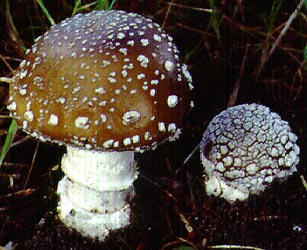|
[ Section Amanitapage. ]
[ Amanita Studies home. ]
[ Keys & Checklist/Picturebooks ] "European Panther"
Technical description (t.b.d.) BRIEF DESCRIPTION: The following is based on a description by Neville and Poumarat (2004) and data from RET. The cap of Amanita pantherina is 37 - 110 mm wide, deep brown or brown-bistre to brown to hazel-brown to pale ochraceous brown, hemispheric at first, then convex to plano-convex, finally planar, viscid and shiny when wet, quickly drying, with a short striate margin (10 - 15% of the radius), nonappendiculate, inflexed at first, then decurved. The volva is present as densely distributed warts, pure white to cream to sordid cream, minutely verruculose, floccose, easily removable. The flesh is white, unchanging when cut or bruised, 6 - 8 mm thick above the stem, thinning evenly toward margin, leaving only a membrane for last few millimeters. The gills are free to remote, close to crowded, white becoming grayish slowly, 7 - 10 mm broad, without a decurrent line on the top of the stem, with a floccose edge. The short gills are truncate. The stem is 50 - 140 × 6 - 20 mm, subcyclindric, somewhat narrowing upward, white, becoming slightly tannish in age, finely floccose becoming smooth above the ring, and with small appressed squamules or creamy floccose material or sometimes rings of such material on the stem above the bulb below the ring. The bulb is 22 - 30 mm wide, round as an onion to ovoid to subfusiform. The ring is placed rather low on the stem (lower than most other European amanitas from section Amanita), membranous, white, quickly collapsing on the stem, usually nonstriate on the upper surface, flaring upward. The volva is white, becoming gray with age, easily broken, and forming at least one ring on the joint of the stem and bulb which is sometimes described as like a rolled sock. The flesh is white, unchanging when cut or bruised, stuffed then hollow. The spores measure (7.5-) 8.5 - 11.7 (-14.0) × (4.9-) 6.2 - 8.1 (-9.8) µm and are broadly ellipsoid to ellipsoid, occasionally elongate, very rarely cylindric, and inamyloid. Clamps are absent at bases of basidia. Spores measured by Neville and Poumarat (2004) are as follows: (7.5-) 8 - 11.2 (-12) × (5-) 5.5 - 8.5 µm and are broadly ellipsoid to ellipsoid to elongate, infrequently globose. This species was originally described from France and can be found under oaks (Quercus), chestnuts (Castanea sativa), and conifers. Neville and Poumarat site a reference reporting the present species with Helianthemum (H. nummularium or H. grandiflorum) in subalpine habitat. The original description is based on both French and German material. It is a species of Europe and western Asia. Material described as A. pantherina in the Americas seems to belong to a number of distinct taxa only some of which have been described: A. multisquamosa Peck, A. pantherina var. pantherinoides (Murrill) Dav. T. Jenkins, and A. velatipes G. F. Atk. are examples. There are also a number of taxa in eastern and southern Asia to which the name A. pantherina has been mistakenly applied. Among these mushrooms there are some which have been described formally or provisionally (such as A. subglobosa Zhu L. Yang, A. parvipanthera Zhu L. Yang, M. Weiss & Oberw., and A. pseudopantherina Zhu L. Yang nom. prov.), while others are not yet treated in the literature. I believe that there is at least one good icon of this mushroom in the collection at the University of Montpellier herbarium. It may date from the period when DeCandolle was on the faculty. [I would appreciate receiving more information on the artwork.] The species is toxic and produces dramatic symptoms similar to those of A. muscaria (L. : Fr.) Lam. -- R. E. Tulloss Photo: R. E. Tulloss (The Netherlands)
[ Section Amanita page. ]
[ Amanita Studies home. ]
[ Keys & Checklist/Picturebooks ] Last changed 2 May 2009. |
